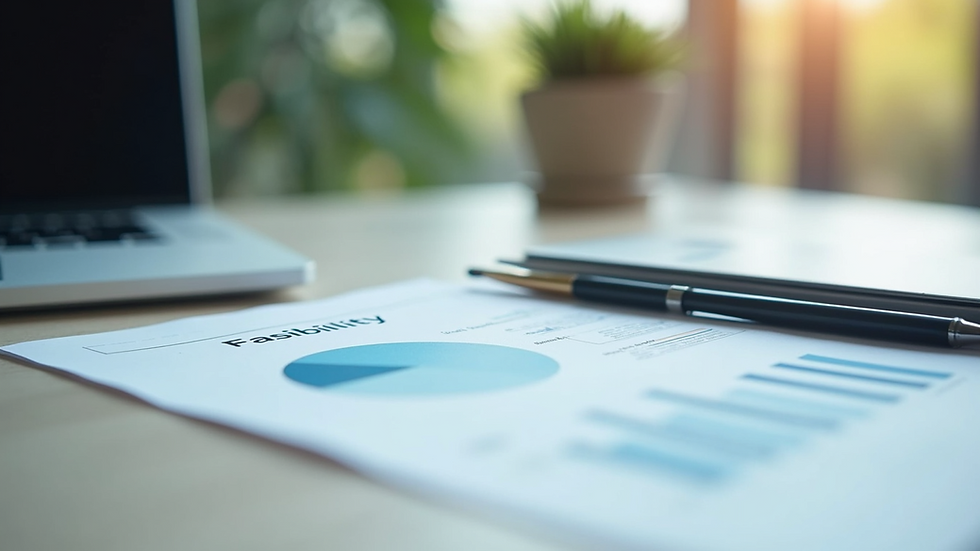SBA Feasibility Study
- tmiller813
- Apr 21
- 4 min read
Updated: May 8
When starting a new business or planning to expand an existing one, an SBA feasibility study is vital.
Whether you are a first-time entrepreneur or a seasoned business owner, understanding the key aspects of this study can significantly boost your chances of success.
This blog post will look into the importance of SBA feasibility studies, the steps involved, and how they can help you achieve your entrepreneurial dreams.
What is an SBA Feasibility Study?
An SBA feasibility study is an in-depth analysis that evaluates whether a proposed business idea or project is viable.
It helps entrepreneurs determine if their plans are practical and likely to succeed in the current market.
By examining factors such as market demand, competition, financial projections, and operational logistics, these studies provide clarity on whether it makes sense to move forward.
Additionally, a thorough feasibility study can be crucial in obtaining funding from lenders, including the Small Business Administration (SBA).
Why is a Feasibility Study Important?
Market Demand Assessment
Evaluating market demand is a core part of a feasibility study.
This means assessing whether there is a sufficient customer base for your product or service.
For instance, a recent study showed that 57% of small businesses fail due to a lack of market need.
Understanding demographics, customer behavior, and market trends can give you valuable insights.
By identifying potential customers and their needs, you can make informed decisions about what products to offer and how to market them effectively.
This understanding is crucial to align your business with consumer expectations.
Financial Projections
Creating detailed financial projections is another essential component of an SBA feasibility study.
This includes estimating start-up costs, operational expenses, predicted revenues, and potential profits.
A survey indicated that 29% of small business owners struggle with cash flow management, which highlights the importance of having accurate financial forecasts.
Having clear financial projections not only helps you understand if your business can be profitable; it also boosts your credibility when seeking funding.
Investors want to see a robust financial plan outlining how their investments will be managed and returned.
Risk Identification
Every business comes with risks, and identifying these challenges is crucial.
Understanding potential risks allows you to create strategies to minimize them.
For example, if external economic conditions pose a threat, a contingency plan may involve diversifying your product offerings or adjusting pricing strategies.
By recognizing potential challenges, you set the groundwork for effective contingency planning and can prepare for any setbacks.
Operational Logistics
An SBA feasibility study also examines the operational logistics involved in starting and running a business.
This includes assessing necessary resources like facilities, technology, and human capital.
For instance, if you plan to open a café, analyzing the cost and location of suppliers and equipment will help avoid future operational hiccups.
By comprehending operational logistics, you can spot potential hurdles early and ensure efficient resource allocation, ultimately saving both time and money once the business is up and running.
Guidance for Decision Making
Ultimately, a feasibility study is an invaluable decision-making tool.
It consolidates all aspects of your business idea into one document, allowing stakeholders to evaluate the pros and cons based on solid data.
This leads to informed choices that align with your strategic goals.
With comprehensive research and analysis at your disposal, you are better equipped to make decisions that promote growth while keeping costs in check.
How to Conduct an SBA Feasibility Study
Step 1: Define Your Business Idea
Begin your feasibility study by clearly defining your business idea.
What product or service will you offer? Identify your unique selling points that set you apart from competitors.
Step 2: Market Research
Conduct detailed market research through surveys, interviews, and industry reports.
This effort will help you understand customer preferences and validate market demand.
Step 3: Financial Analysis
Gather data to forecast your finances, including start-up costs and anticipated revenues.
Collaborating with a financial expert can ensure your forecasts are accurate.
Step 4: Identify Risks and Challenges
List potential risks associated with your business concept.
This could include market instability or regulatory changes.
Analyze how these risks might affect your operations and profitability.
Step 5: Analyze Operational Requirements
Evaluate the resources and logistics required for launch. Identify suppliers, facilities, and workforce needs essential for your business.
Step 6: Compile the Study
Gather your findings into a structured document.
Ensure that the data is presented clearly and concisely, making it easy for stakeholders to comprehend.
Step 7: Review and Revise
Before finalizing your study, review your findings for clarity and accuracy.
Consider feedback from peers or mentors, and make necessary revisions to enhance the quality of your study.
The Path to Success
Incorporating an SBA feasibility study into your entrepreneurial journey is essential.
This structured approach helps you analyze every detail of your business idea.
By understanding market demand and financial viability, you prepare yourself for the challenges ahead.
The insights generated from a feasibility study can make a considerable difference between a successful launch and a costly mistake.
Whether you're aiming to start fresh or expand, dedicating time and resources to a thorough feasibility study can lead to lasting success.
By leveraging this critical tool, entrepreneurs can make informed decisions that foster sustainable growth and thrive in their industries.






Comments